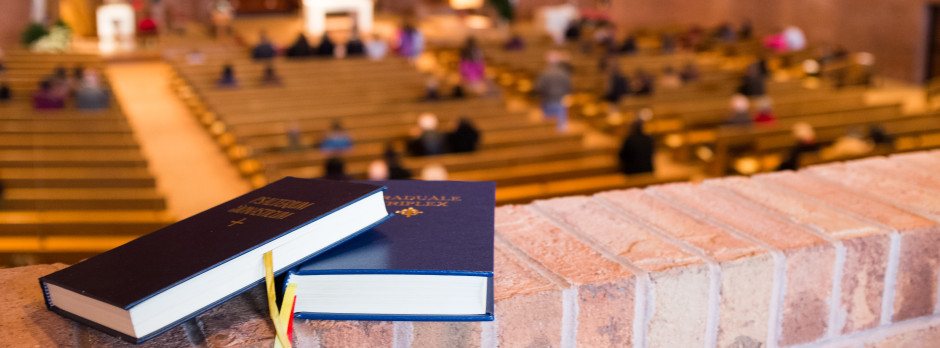Pope St. Gregory the Great (540-604)

One of only two popes to be declared a Doctor of the Church, St. Gregory was a scion of the gens Amicia, an ancient Roman family of senatorial rank. His education was appropriate to his rank, and he became an excellent grammarian and rhetorician, and probably also studied law. His home was deeply Christian, and he learned the Faith both from conversation with family and friends and from his own studies of the Scriptures. He initially launched himself on a public career, becoming prefect of the city of Rome in 573. A year later, he had resigned his office, converted his family’s Sicilian estates into monasteries, and his own home on the mons Caelianus into a monastery dedicated to St. Andrew where he himself enrolled. He later described his monastic period as the happiest time of his life, but it ended in 578 when Pope Pelagius II ordained him a deacon and sent him as legate to the imperial court at Constantinople. The Lombards were rampaging in northern Italy, and the Pope desired to secure aid from the Byzantines. Gregory’s political mission was a failure, and it was from this failure that he probably derived his later public policy as Pope. Spiritually, however, Gregory’s mission was fruitful; he met St. Leander of Seville, who requested that he compose his moral commentaries on Job, and he engaged in a controversy with the Patriarch of Constantinople over the physicality of the risen Christ, in which debate he defended the orthodox belief.
In 586 he was recalled to Rome, and made abbot at St. Andrew’s, but he did not have much rest. His famous attempted mission to Britain, caused by the sight of young Anglo-Saxons in a slave market, was thwarted by the Romans themselves; they regarded him highly and felt that he must not leave the city. A series of disasters afflicted Italy in 589, including a plague and a flood; one year later Pope Pelagius died, and Gregory was elected his successor. Gregory was terrified at the prospect, and refused to accept his election, but the city prefect suppressed his letter urging the Emperor not to confirm his papacy, and in due course he was installed as Bishop of Rome.
For the next fourteen years Gregory acted as civil ruler of Rome and her dependencies, Patriarch of the West, universal shepherd, and theologian all at once. He reformed the Roman liturgy, although the legend that he wrote down the chant which currently bears his name is false; he preserved Rome from the onslaught of the Lombards; he maintained good relations with the Eastern patriarchs, although he had an ongoing controversy over primacy and authority with Constantinople; he sent St. Augustine of Canterbury to evangelize the English; he continued to write, although not as prolifically as before. Ill health, probably exacerbated by severe penances during his monastic period, dogged him all through his papacy, although it did not slow down the fever pitch of his work.
His last years were marked with suffering, and he finally died on 12 March 604. His epitaph reads consul Dei, but he preferred the title which Popes ever since have also borne, servus servorum Dei. He was canonized almost immediately by popular acclamation.
St. Gregory’s feast is celebrated on September 3.
St. Romanos the Melodist (490-556)

St. Romanos was born in Syria to Jewish parents. At an early age he was baptized, and as an adolescent he served as verger in the church of Edessa, his birthplace. As a young man he traveled to Beirut, where he was made deacon. His voice was adequate though not particularly beautiful, but he was regarded highly for his simplicity and holiness, and loved to serve in the liturgy.
During the reign of Anastasios I he moved to Constantinople and served at the church dedicated to the Mother of God near the Blachernae Gate. His holiness and virtue gained him the friendship of the Patriarch, who advanced him in rank beyond that which his voice and theological training would have otherwise indicated. Other singers were not so well-pleased, mocking and deriding him for his lack of talent. For his part, Romanos was aware of his shortcomings and sought to improve them.
In 518 Romanos was selected to lead the singing at the Great Compline on Christmas. At the time, the singer was expected not only to lead singing but also to compose the text and music to be sung. Romanos knew himself inadequate to the task, and buried himself in prayer before the icon of the Mother of God, tearfully entreating her help. He fell asleep, and in a dream beheld her holding a scroll out to him, saying “Eat this.” He did so, and then awoke from the dream, refreshed in spirit. He prepared for the liturgy, and when it came time to do so, he approached the ambo, in the presence of Emperor and Patriarch, and in a beautiful clear voice sang a profound hymn, beginning thus:
Today the virgin gives birth to the transcendent one,
And the earth offers a cave to the unapproachable one.
Angels, with shepherds, glorify Him.
The wise men journey with the star,
Since for our sake the eternal God was born as a little child!
[The text of the entire hymn]
Afterwards he told the Patriarch of his vision, and the singers who had previously mocked him repented and asked his forgiveness. Romanos subsequently wrote over a thousand hymns, called kontakia in Greek, for use in the Divine Liturgy, many of which are still in use.
St. Romanos has no official commemoration in the Roman calendar, but the Byzantines celebrate his feast on October 1.
